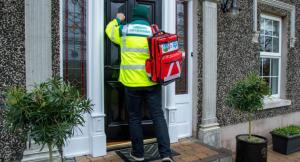Community First Responder Schemes are made up of volunteers who live within their local community. The Northern Ireland
Community First Responders (CFRs) provide critical, life-saving support in the vital minutes before an emergency ambulance arrives. As of September 2025, over 450 dedicated CFRs across 25 schemes are on call, ready to respond at a moment’s notice, working closely with the Northern Ireland Ambulance Service (NIAS). These highly trained volunteers live within the communities they serve, allowing them to reach potentially life-threatening emergencies much faster than an emergency ambulance, particularly in rural areas where response times may be longer.
Research in the UK has demonstrated the significant impact CFRs have on emergency care. Studies show that CFRs contribute meaningfully to call coverage and response rates, often arriving on scene first and providing essential early life support. In rural communities, CFRs reduce the time to first assessment, which is critical in improving patient outcomes. While survival rates can vary depending on the type of emergency, evidence indicates that the timely intervention of CFRs may increase the chances of survival, helps stabilise patients, and can reduce the strain on ambulance services.
Beyond the clinical impact, CFRs provide reassurance and emotional support to patients and their families during highly stressful situations, demonstrating the unique human element of this volunteer role. Their presence strengthens the overall emergency response system, offering a cost-effective, rapid and compassionate layer of care. In short, CFRs embody the spirit of community, courage, and commitment, often making the difference between life and death in their local areas.
What is a Community First Responder (CFR) Scheme?
A Community First Responder (CFR) Scheme is made up of trained volunteers who live within the community they serve.
When certain 999 calls are made, the Northern Ireland Ambulance Service (NIAS) can alert nearby CFRs at the same time as dispatching an emergency ambulance. Their aim is to reach the patient in the vital first few minutes before ambulance crews arrive.
CFRs are trained to:
- Provide Basic Life Support (BLS)
- Use an Automated External Defibrillator (AED)
- Place unconscious casualties into the Recovery Position
- Provide life saving interventions to the chocking casualty
- Update the Emergency Operations Centre (EOC) as required
They work alongside NIAS, never replacing emergency ambulance crews, but providing immediate and often lifesaving care until advanced help arrives.
Why Do We Need Community First Responders?
When someone suffers a cardiac arrest, the heart stops pumping blood and breathing stops! This is when every second counts.
- Survival chances drop by about 10% for every minute without CPR and Defibrillation.
- Quick action is vital to give the best possible chance of survival.
CFRs can often be there in minutes. Because they live locally, CFRs can often reach the patient before the ambulance arrives. In many emergencies, those few minutes can be the difference between life and death.
In Northern Ireland:
- Around 1,500 Out of Hospital Cardiac Arrests (OHCA) occur each year where resuscitation is attempted.
- Less than 1 in 10 people survive to return to their families.
- In rural areas, longer ambulance response times increase the need for early local intervention.
The Chain of Survival
CFRs are trained in the first three links of the Chain of Survival:
- Early recognition of Cardiac Arrest
- Early CPR
- Early defibrillation
By delivering these critical first steps, CFRs can greatly improve a casualty’s chances of survival and sometimes, they truly are the difference between life and death.

What Type of Incidents Are CFRs Alerted To?
CFRs are usually called to potentially life-threatening medical emergencies where their rapid arrival could make a positive impact on patient outcomes.
Currently, CFR’s are alerted by NIAS to attend:
- Cardiac arrest
- Chest pain
- Choking
- Unconscious casualties
- Seizures
CFRs are not knowingly alerted to:
- Patients under 12 years old
- Trauma incidents
- Situations involving possible hazards (alcohol, drugs, or potential violence)
- Mental Health Crises
More Than Medical Care
In addition to emergency life support, CFRs provide vital reassurance and comfort to patients and relatives during distressing situations. This support that can be just as valuable as medical treatment.
How Do CFR Schemes Work?
Community First Responder Schemes operate in partnership with the Northern Ireland Ambulance Service (NIAS) to deliver rapid emergency life support to patients.
While NIAS does not fully govern or fund CFR Schemes, it provides:
- Clinical governance and indemnity
- Clinical guidance and training
- Support to maintain a scheme
- Volunteer dispatching and troubleshooting assistance
- Welfare support for volunteers
CFR Schemes themselves are usually set up as independent community groups or charities. Each scheme has a Co-ordinator who:
- Acts as a point of contact for CFR volunteers
- Serves as a point of contact with the Ambulance Service
What Training is Provided?
Training for new CFRs is delivered by the Community Resuscitation Team within NIAS
The process includes:
- Initial Training – a two-day course held over a weekend in our Clinical Education Training Centre in Knockbracken Healthcare Park covering essential skills.
- Additional Training – offered or signposted as relevant to the role.
- Mentorship – new CFRs are recommended to work alongside an experienced CFR to build confidence.
- Ongoing Updates – refresher training every 12 months held at your local Scheme, plus non-clinical courses such as moving & handling and infection prevention & control.
If you have a query not covered here, please contact the Community Resuscitation Team at resus.admin@nias.hscni.net or call 028 9040 52156
